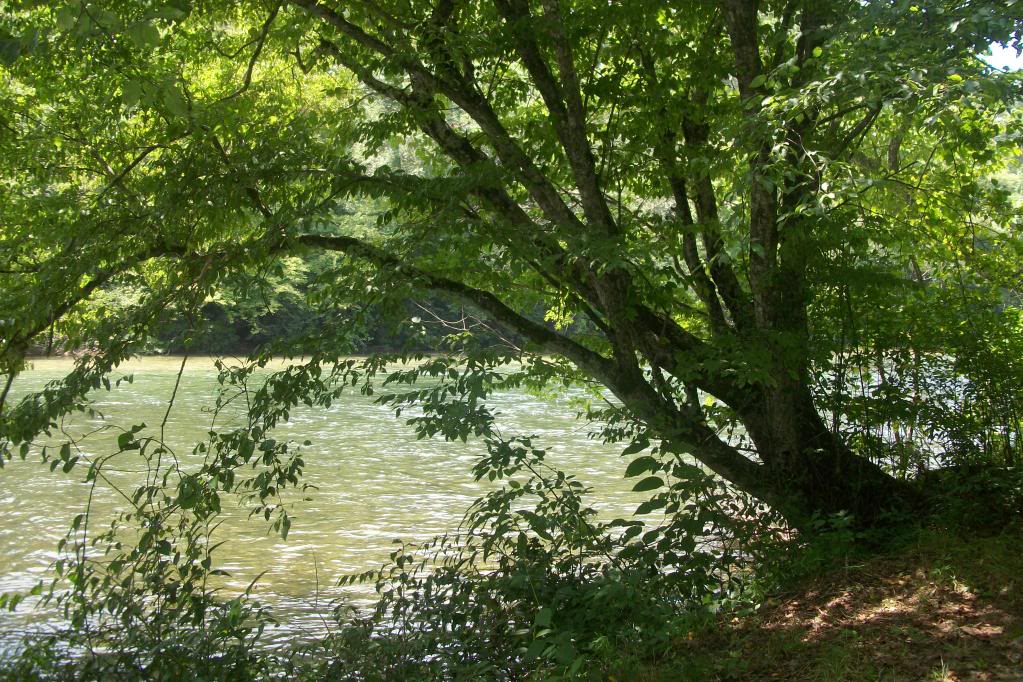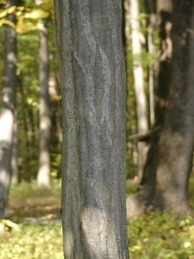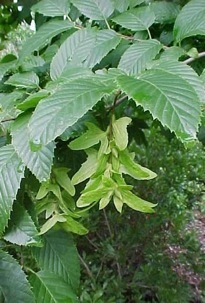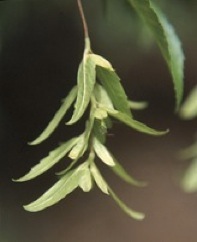Carpinus caroliniana: Musclewood
British author Ray Mears must have been thinking of the Hornbeam when he said a forager mustn’t pass up food no matter how meager.
Not all of the wild edibles can produce the best-tasting and most plentiful foods, but many can make their small contribution. And so it is with the American Hornbeam, Carpinus caroliniana, (kar-PYE-nus kair-oh-lin-ee-AY-nuh.)
Where I grew up it was called Ironwood or Hornbeam (which means hard tree.) Here in the South you’ll hear it called Blue Beech or Water Beech. While it is not a beech per se, its leaves — which turn orange red in the fall — can remind one of a beech as can its bark. But the hornbeam has its own special look, and it is of a well-muscled, sinewy tree.
Hornbeam looks taut, cut and buff, as if it goes to the forest gym twice a day and lifts … iron. Hence its other common name: Musclewood. Once you have the look of a Hornbeam inside your head you will always recognize it easily.
Hornbeam never grows to a huge size, perhaps six or seven inches through on average. But, it is strong and dense, 45 pounds per cubic foot. It’s been used for tool handles and support poles and
as well as bowls and dishes because it does not crack or split or have any flavor. It used to be favored to make charcoal powder.
Related to the Alders, Birches, Filberts, and Hophornbeams, the edible part are small nutlets,
though the bark does have some medicinal uses and the leaves have been employed as an astringent. There are some 33,000 seeds to a pound, though every three to five years the tree will produce larger crops than usual. A heavily seeding tree is between 25 and 50 years old. As fare goes, the nutlets are neither great nor awful, but they are small, which is why they are diminished by most writers. They can be eaten raw or roasted. Ray Mears also reports the sprouts are edible.
As for its scientific name, Caroliniana (like Virginiana) means North America, or at least central North America. Carpinus is the classical Latin name for the Hornbeam, and comes from “carpentum” a Roman horse-drawn vehicle with hard-wood wheels.
The Hornbeam grows throughout eastern North American, from Florida to Quebec, Louisiana north to Ontario It is also found in Texas, Arkansas, central and southern Mexico, Guatemala,
and western Honduras. In timberland the Hornbeam is considered a tough weed because it is too small for commercial use. However, it makes a good firewood.
Seeds of the Hornbeam are an important food for squirrels. Seeds, buds, and or catkins are consumed by many birds: Ruffed grouse, ring-necked pheasants, bobwhite, turkey, ducks and warblers. The fox will eat the seeds as well. Leaves, twigs, and larger stems are eaten by cottontails, beaver, and white-tailed deer. Deer will eat the shoots but it is not a preferred food. The Hornbeam, however, is heavily used by beaver because it is common their habitat. It is also the larval host of several butterflies including the Eastern Tiger Swallowtail, Striped hairstreak, Red-spotted Purple, and Tiger Swallow-tail.
Green Deane’s “Itemized” Plant Profile
IDENTIFICATION: A small tree, nearly shrubby, to 25 feet,rounded crown, twisted trunk. Leaves alternate, simple, elliptical to oval, 3 to 5 inches long, smaller on younger trees, pinnately veined, tip tapers to a sharp point, long and short teeth on leaves, smooth green above, paler below. Seeds, small, quarter to one third inch, ribbed nutlet on a 3-lobed, slightly folded leafy bract (resembles a maple seed), clustered on a long hanging stalk.
TIME OF YEAR: Flowers March to May, nutlets late August to winter. Wind can disperse them up to 64 feet from the tree.
ENVIRONMENT: Moist areas of established forests, occasionally fields. Makes a nice small yard tree, slow growing.
METHOD OF PREPARATION: Nutlets raw or roasted, boiled or ground to add to other flours or food. Take the papery bracts and rub them between you hands to free the nutlets.






Wow… I’ve been going to a campsite for 6 years without knowing what that tree was. My cousins and I always built forts in them and love the twisted trunk. Now that I know what it is, you’ve made my camping trips more interesting… Thx
been wondering about this tree for more than 50 years, thanks Google! First encountered this tough tree in the Kentucky Woodlands portion of what is now The Land Between The Lakes . Have never seen anything but mature , but small shrub like trees . Wonder if a bow could be made from this wood? Or knife handles or duck calls ? Possibly a guitar neck?
I don’t think it has the flexibility for a bow but I am not a bow maker. It was used for tool handles.
Saw that you mentioned hop hornbeam wouldn’t make a good archery bow. The Primitave Archer website says it’s #2 with osage-orange being #1. It is indeed a very hard, heavy and stiff wood.
This wood is excellent for making bows, furniture, or anything else that you want to last forever. Must be debarked in the spring when the bark is at its slipperiest. And it takes quite a bit of time to cure being that it’s very hard. But you could probably find someone in your area that will kill dry it for you professionally and slowly takes about a week.
Best wood for bow making from what I’ve read is osage orange wood.
Cherokee used black locust, and Osage orange. It is more flexible than hickory and just as tough, I don’t know why everyone thinks oasage orange is the only bow wood
Love this website, especially the archives. My co-worker and I are teaching a few foraging/survival classes to staff and we are learning Volumes from your website.
I do have a comment regarding Hornbeam vs. Hop Hornbeam… I have learned my trees (in Illinois and North Carolina) and we refer to Hornbeam- Carpinus caroliniana as “Musclewood”, and Hop Hornbeam- Ostrya virginiana as “Ironwood”. Seems pretty uniform across the board with the other arborists in my field that I’ve come encountered. We also refer to Musclewood as Blue Beech. (Funny how one tree can have so many slang names!) Just thought that was interesting and notable, if there were regional differences in the nickname Ironwood for two different species.
I am trying to find the name of a tree that was in my parent’s back yard. It appears to have parts of the trunk that wrap around the main trunk, like you could put your elbows inside one another and wrap your arms around each other. The lowest branches on the tree spread out well beyond what would be a normal drip edge and I think the top resembled a point, like a Christmas tree, but not as well defined. It was planted near to a Katsura tree and for a long time I thought that the tree I am describing was the Katsura. My friend, a landscape architect,told me to try this Carpinus caroliniana. Does the musclewoon wrap around itself? Please make another suggestion if it does not wrap a round. Thank You
Hello,
I have frankly loved this tree for a long time and I have finally found a place to take a couple from the wild and I want to be careful so that I can achieve success in the Transplanting. There was one on a property my Father owned and later sold. He had been a policeman most of his adult life and at some point someone made him a Billy Club from a chunk of Ironwood. I still have it. And, I want to put two in my yard. Do these trees have a deep taproot or shallow roots, and what extra care to take in digging up and transplanting? I consider myself as a proverbial green thumb and can get most things to survive but I read it is difficult to transplant so I want to take precautions.
Where can I buy hornbeam seeds for eating, hornbeam leaves for making tea or do anything else herbal with hornbeam. The Bach Flower Remedy does somewhat decrease my fatigue, but I need something stronger. Likewise I have noticed that birch essential oil does slightly decrease my fatigue, so perhaps other products from the birch family might be helpful also?
Hi John!
If you are still searching for it, this fall I can probably gather some for you, we have the ‘blue beech’ hornbeam, and in fact I was looking around online to identify the trees in order to make the ‘hornbeam’ bach flower remedy for someone.
I do SASE’s on the ‘seed exchange’ on the gardenweb forum, just message me there (my handle is mersiepoo).
My brother-in-law is a bow maker and tells me American Hornbeam will make a good bow.
I didn’t discover this tree until I retired and moved to the city – and finally have time to “look” at my surroundings. I bought two tiny trees at a local native plant sale that I am pruning to keep as single trunk trees. I liberated another one in the woods (sorry, I shouldn’t have, but……). This one has a single trunk that was growing from the root of another tree with only sparse roots of its own. I planted it and mulched, and watered frequently for two years. Now, in its third year, (in an unusually hot and dry summer) I still never let it get too dry. It’s doing well and seems happy in its new setting – a little woodland that I planted at the back of our yard. I live close to Niagara Falls, Ontario and looked in a local park to see what grows naturally in this area. And so my private woodland has the same trees – blue beech, black gum, sassafrass, spicebush, along with the existing tulip trees, thornless honey locust, cedar, and spruce. I wanted some instant trees, too so had two large freeman maples planted to hide the neighbour’s balcony. The existing trees are not what I would have chosen, but trees are precious and so they will remain.
He’s incorrect about how big a hornbeam can get; if you hike the Appalachian Trail in Virginia, you will see hornbeam trees up to 48 inches in diameter….great, beautiful, monstrous trees that look like they’re built out of skin-wrapped bundles of rope. I suspect their great size is primarily due having to reach for the sun among the oaks and poplars.
Interesting… I’ve found some persimmons near 70 feet tall doing the same thing riverside. But the usual size is much smaller.
Dr. Green Deane,
May I humbly suggest you take a trip to Texas. Not only is it a great nature state to visit, but you have just about written about all the useful plants in Florida (and have started on imported plants, ornamentals and accidentals). You have lots of avid readers here (and neighboring states) and it will extend the life of your blog.
Thanks all the wonderful info and reading time you have given me. I have found lots of your species here in Fort Bend County, Texas.
Thanks again,
Ted Donaho
pbsdonah@hal-pc.org
Thanks… have you visited the site Foraging Texas?
Ray Mears is not just an author, but also has several television series about traditional survival skills and wild foods. Some of these shows are available on YouTube and are very well done, with respect for the natural world and appreciation for the knowledge and cultural traditions of people all over the world whose way of life has not yet been completely obliterated by industrialization.
We are all waiting for the TV show featuring our favorite American forger – Green Deane!
I think you mean for(a)ger, nor forger….
For Robert,
When I liberated my tree(s) from the woods, I found that they are “sprouts” growing from the roots of another tree. They had only very sparse roots of their own. I dug about 12″ laterally on both sides of the little tree, cut the lateral root and pulled it up. The small trees own roots were very shallow, so with my pruners it was very easy to liberate the tree. I watered them well in the first two years and they are thriving. I want trees rather than multiple trunks so I am pruning them up before I allow them to branch.
Are the seeds from the hop horn beam tree edible as well?
I really don’t know.
My ironwood tree is dying – leaves have already turned yellow and are falling off. The tree is at least 22 years old, and probably a good bit older than that. Any idea what is killing it? I also have a mimosa that is dying on the opposite side of my house – think it has mimosa wilt. Any chance there is a connection?